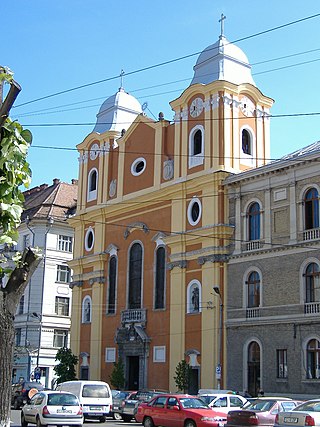
Transylvania is a historical and cultural region in Central Europe, encompassing central Romania. To the east and south its natural border is the Carpathian Mountains and to the west the Apuseni Mountains. Broader definitions of Transylvania also include the western and northwestern Romanian regions of Crișana and Maramureș, and occasionally Banat. Historical Transylvania also includes small parts of neighbouring Western Moldavia and even a small part of south-western neighbouring Bukovina to its north east.

Cluj-Napoca, or simply Cluj, is a city in northwestern Romania. It is the second-most populous city in the country and the seat of Cluj County. Geographically, it is roughly equidistant from Bucharest, Budapest and Belgrade. Located in the Someșul Mic river valley, the city is considered the unofficial capital of the historical province of Transylvania. For some decades prior to the Austro-Hungarian Compromise of 1867, it was the official capital of the Grand Principality of Transylvania.

Aiud is a city located in Alba County, Transylvania, Romania. The city's population is 21,307 (2021). It has the status of municipiu. The city derives its name ultimately from Saint Giles (Aegidius), to whom the first church in the settlement was dedicated when built.
Avram Iancu Cluj International Airport is an airport serving the city of Cluj-Napoca, Romania. Initially known as Someșeni Airport, it is located 9 km (5.6 mi) east of the city centre, in the Someșeni area, which is now within the Cluj-Napoca city limits. The airport is named in honour of Romanian revolutionary Avram Iancu.

Dej is a municipality in Transylvania, Romania, 60 kilometres (37 mi) north of Cluj-Napoca, in Cluj County. It lies where the river Someșul Mic meets the river Someșul Mare. The city administers four villages: Ocna Dejului (Désakna), Peștera (Pestes), Pintic (Oláhpéntek), and Șomcutu Mic (Kissomkút).

The St. Michael's Church is a Gothic-style Roman Catholic church in Cluj-Napoca. It is the second largest church in the geographical region of Transylvania, Romania. The nave is 50 meters long and 24 meters wide, the apse is 20×10 m. The tower with its height of 76 meter is the highest one in Transylvania.

Troesmis was an ancient Dacian town and later ancient Roman city and legionary fortress, a major site situated on the Danube and forming a key part of the Limes Moesiae frontier system. Around the fortress the Geto-Dacian town developed.

Aiton is a commune in Cluj County, Transylvania, Romania. It is composed of two villages, Aiton and Rediu (Rőd).

Chinteni is a commune in Cluj County, Transylvania, Romania. It is composed of nine villages: Chinteni, Deușu (Diós), Feiurdeni (Fejérd), Măcicașu (Magyarmacskás), Pădureni, Săliștea Veche (Szellőcskevölgy), Sânmărtin (Szentmártonmacskás), Satu Lung (Hosszúmacskás) and Vechea (Bodonkút).

U-Banca Transilvania Cluj-Napoca, commonly known as U-BT Cluj-Napoca, is a professional basketball club based in Cluj-Napoca, Romania that competes domestically in the Liga Națională de Baschet and internationally in the EuroCup. Like other teams that were initially part of the Universitatea Cluj multi sports club, the basketball team keeps the letter U in its name. The main sponsor of the team is the locally based banking institution Banca Transilvania. The team colors are black and white. U-BT Cluj-Napoca plays its home games at the BTarena, which accommodates 10,000 spectators, or in Horia Demian Sports Hall with a capacity of 2,525 spectators.
Claudiopolis is the name of a number of ancient cities named after Roman emperor Claudius or another person bearing that name, notably:

The Technical University of Cluj-Napoca is a public university located in Cluj-Napoca, Romania. It was founded in 1948, based on the older Industrial College (1920). The Technical University of Cluj-Napoca is classified by the Ministry of Education as an advanced research and education university. The university is a member of the Romanian Alliance of Technical Universities (ARUT).

Iulian Pop was an Austro-Hungarian and Romanian lawyer and politician, who became the first Romanian mayor of Cluj on 19 January 1919, a month after Transylvania became part of the Romanian state. He remained mayor until 13 April 1923, when he resigned for health reasons and was succeeded on an interim basis by Aurel Moga.
The history of Cluj-Napoca covers the time from the Roman conquest of Dacia, when a Roman settlement named Napoca existed on the location of the later city, through the founding of Cluj and its flourishing as the main cultural and religious center in the historical province of Transylvania, until its modern existence as a city, the seat of Cluj County in north-western Romania.

The Piarist Church, located at 5 Str. Universității, Cluj-Napoca, Romania, and dedicated to the Holy Trinity, was the first Roman Catholic church built in Transylvania after the Protestant Reformation, as well as the province's first Baroque church building. Among the city's more notable edifices, it served as a prototype for numerous other churches in Transylvania. It features a strong contrast between the sober exterior and a very well-decorated, almost exuberant interior. A statue of the Virgin Mary stood in front of the church until 1959, when the Communist authorities moved it to another part of the city.

Milliarium of Aiton is an ancient Roman milliarium (milestone) discovered in the 1758 in Aiton commune, near Cluj-Napoca, Romania. Dating from 108 AD, shortly after the Roman conquest of Dacia, the milestone shows the construction of the road from Potaissa to Napoca, by demand of the Emperor Trajan. It indicates the distance of ten thousand feet (P.M.X.) to Potaissa. This is the first epigraphical attestation of the settlements of Potaissa and Napoca in Roman Dacia.

Napoca was a Roman castra (fort) in the province of Dacia.
Arcobara was a Dacian town mentioned by Ptolemy.

The following detailed sequence of events covers the timeline of Cluj-Napoca, a city in Transylvania, Romania.
Clus may refer to Cluj-Napoca, a city in Cluj County, Romania.














